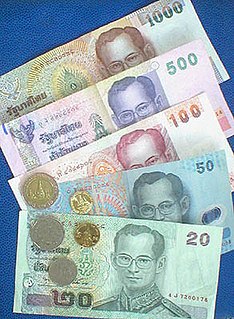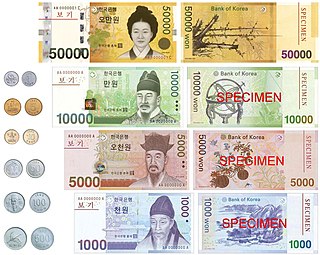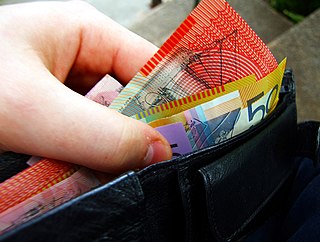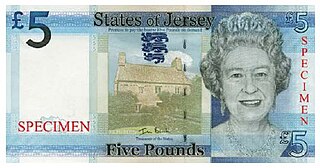
Baht is the official currency of Thailand. It is divided into 100 satang. The issuance of currency is the responsibility of the Bank of Thailand.

The krone is the official currency of Denmark, Greenland, and the Faroe Islands, introduced on 1 January 1875. Both the ISO code "DKK" and currency sign "kr." are in common use; the former precedes the value, the latter in some contexts follows it. The currency is sometimes referred to as the Danish crown in English, since krone literally means crown. Historically, krone coins have been minted in Denmark since the 17th century.

The tenge is the currency of Kazakhstan. It is divided into 100 tıyn. The ISO-4217 code is KZT.

The rupee is the currency of the Seychelles. It is subdivided into 100 cents. In the local Seychellois Creole (Seselwa) language, it is called the roupi. The international currency code is SCR. The abbreviations SR and SRe are sometimes used. Seychelles is the smallest country to have an independent monetary policy. Several other currencies are also called rupee.

Sterling banknotes are the banknotes in circulation in the United Kingdom and its related territories, denominated in pounds sterling.

The South Korean won or Korean Republic won is the official currency of South Korea. A single won is divided into 100 jeon, the monetary subunit. The jeon is no longer used for everyday transactions, and appears only in foreign exchange rates. The won is issued by the Bank of Korea, based in the capital city of Seoul.

The rial is the currency of Iran.

Polymer banknotes are banknotes made from a synthetic polymer such as biaxially oriented polypropylene (BOPP). Such notes incorporate many security features not available in paper banknotes, including the use of metameric inks. Polymer banknotes last significantly longer than paper notes, causing a decrease in environmental impact and a reduced cost of production and replacement. Modern polymer banknotes were first developed by the Reserve Bank of Australia (RBA), Commonwealth Scientific and Industrial Research Organisation (CSIRO) and The University of Melbourne. They were first issued as currency in Australia during 1988. In 1996 Australia switched completely to polymer banknotes. Other countries that have switched completely to polymer banknotes include: Brunei, Canada, Maldives, Mauritania, Nicaragua, New Zealand, Papua New Guinea, Romania and Vietnam. The latest countries to introduce polymer banknotes into general circulation include: the United Kingdom, Nigeria, Cape Verde, Chile, The Gambia, Nicaragua, Trinidad and Tobago, Mexico, Botswana, São Tomé and Príncipe, North Macedonia, the Russian Federation, Armenia, Solomon Islands, Egypt, the Organisation of Eastern Caribbean States (OECS), Samoa, Morocco, Albania and Cambodia.

The pound is the currency of Jersey. Jersey is in currency union with the United Kingdom, and the Jersey pound is not a separate currency but is an issue of banknotes and coins by the States of Jersey denominated in pound sterling, in a similar way to the banknotes issued in Scotland and Northern Ireland. It can be exchanged at par with other sterling coinage and notes.
The Irish Free State, subsequently known as Ireland, resolved in the mid-1920s to design its own coins and banknotes. Upon issuing the new currency, the Free State government pegged its value to the pound sterling. The Currency Act, 1927 was passed as a basis for creating banknotes and the "Saorstát pound" as the "standard unit of value." The legal tender notes issued under this act began circulating on 10 September 1928.
The Series B Banknotes of Ireland replaced the Series A Banknotes. The banknotes were issued between 1976 and 1992 by the Central Bank of Ireland, the series was replaced in 1993 by Series C Banknotes.
The Series A Banknotes were introduced by the Irish Free State in 1928 and were the first banknotes created by and for the state; the series continued to be issued when the Free State became Ireland. The notes served from 1928 to 1977 and were replaced by Series B notes.
The Currency Commission, was created by the Currency Act, 1927 as part of the policy of the Irish Free State to create the 'Saorstát pound'. The Currency Commission commissioned the Series A Banknotes, through the advice of an advisory commission. It also issued the Ploughman series of banknotes for Irish banks, which were legal tender until 1953.
The banknotes of the Australian dollar were first issued by the Reserve Bank of Australia on 14 February 1966, when Australia changed to decimal currency and replaced the pound with the dollar. This currency was a lot easier for calculating cost rather than the British pound, shilling and pence system.
Banknotes have been issued by the Bank of Ireland for circulation in Northern Ireland since 1922.

The Bank of Ireland £5 note is a banknote of the pound sterling. It is the smallest denomination of banknote issued by the Bank of Ireland.
The Bank of Ireland £10 note is a banknote of the pound sterling. It is the second smallest denomination of banknote issued by the Bank of Ireland.
The Bank of Ireland £20 note is a banknote of the pound sterling. It is the third largest of five denominations of banknote issued by the Bank of Ireland.
The Bank of Ireland £50 note is a banknote of the pound sterling. It is the second largest denomination of banknote issued by the Bank of Ireland.
The Bank of Ireland £100 note is a banknote of the pound sterling. It is the largest denomination of banknote issued by the Bank of Ireland.










